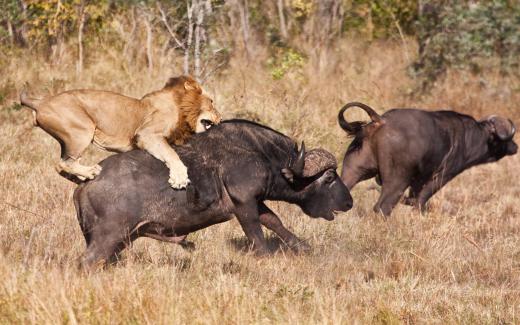What are Some Extinct Animals of North America?
 Michael Anissimov
Michael Anissimov
Like everywhere else, numerous animals in North America went extinct shortly after the end of the last Ice Age, about 12,000 years ago. Humans are thought to be the cause. Other animals went extinct millions of years earlier, during the Pleistocene. Many of these are large animals, and are referred to as megafauna. Little of the North American megafauna survives -- some examples include bears and American Bison. Of all the extinct animals from North America, most of them went extinct just as soon as humans were getting more numerous.
Some of the fascinating extinct animals that lived in North America include the American Lion, which is the largest subspecies of lion ever to have existed, and is 25% larger than the African lion (extinct 8000 BC); the Ancient Bison, which was the most numerous large herbivore for 8,000 years until it went extinct around 8000 BC; Cuvieronius, a large elephant with spiral tusks (extinct 7000 BC); the Dire Wolf, a large wolf that went extinct in 8000 BC; the Giant Beaver, with a length of up to 2.5 m (8.2 ft) that lived around the Great Lakes until 10,000 years ago; and the Giant Hutia, a rodent that could grow to the size of bears, which lived in Puerto Rico until just 3,000 years ago. Except for the Ancient Bison and the Dire Wolf, few of these extinct animals have living relatives.

There are many other extinct animals from North America. The Giant Short-Faced Bear, which is the largest bear that ever lived, standing at seven feet tall and ten feet long (extinct 10,500 BC); Glyptodon, an armadillo-like armored animal about the size of a VW Bug, which originally evolved in South America but moved to Texas; the famous saber-toothed tiger, which was a top predator in Pleistocene North America; the well-known Wooly Mammoth, with adaptations to Ice Age living, and is often found frozen in Canadian permafrost; and the American Cheetah, a cheetah-like animal more closely related to the modern Puma, and which is known only from bone fragments.
There are numerous other extinct animals from North America over its hundreds of millions of years of natural history, but this article just covered those that went extinct most recently.
AS FEATURED ON:
AS FEATURED ON:














Discussion Comments
Are any "extinct" animals still alive in North America? For example, I know that scientists are finding more and more living fossils every day, like the coelacanth and those sharks with the giant mouths.
Is there speculation about any of the extinct animals listed above still existing in North America?
I was once fortunate enough to go to an environmental center with an extinct animals "zoo", where they showed holograms of extinct animals like the ones mentioned above as they might have looked and acted in their daily lives.
Although the giant armadillos were actually kind of cute, I can't even imagine living in a world where giant short-faced bears lived -- you really don't get an idea of how truly massive those things were until you see a reproduction up close.
All things considered, I can't say I'm overly sorry that they got added to to the extinct animals list, because those things are just way too scary.
This article was so interesting. When I think about extinct animals, I always think of really far out things, like saber-tooth tigers and dinosaurs.
But it's fascinating (if sad) to see a list of the modern extinct animals like the one provided here.
I mean, American bison are going extinct as this is written, and just think about things like the passenger pigeon.
I have to say though, although the extinction of animals is always sad, I can't say I'm too torn up about the giant hutia going extinct.
I would hate to imagine the state of affairs if a city got a hutia infestation!
Post your comments